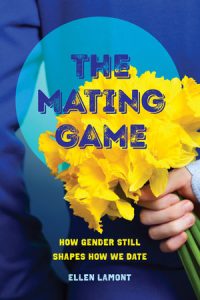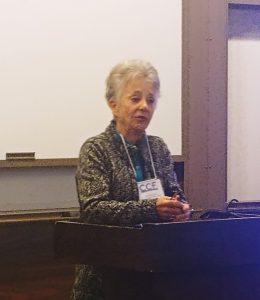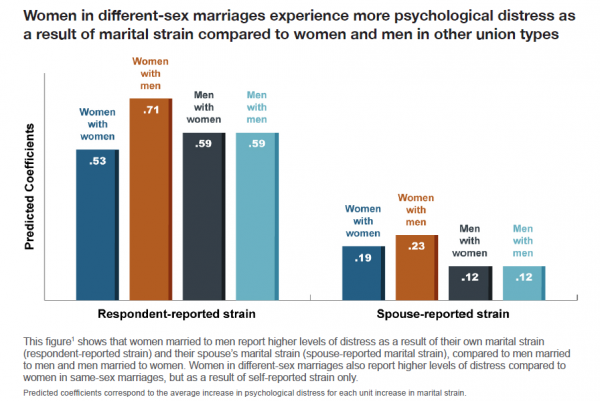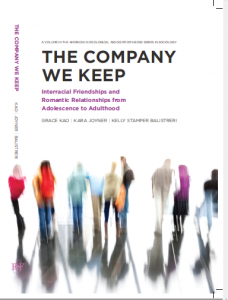 The Defining Consent Online Symposium (.pdf) was convened for the Council on Contemporary Families by Stephanie Coontz and Paula England, who prepared this overview of the seven-part series. Their takeaway: Let’s reject simplistic answers and deal with the complicated realities of sex on campus.
The Defining Consent Online Symposium (.pdf) was convened for the Council on Contemporary Families by Stephanie Coontz and Paula England, who prepared this overview of the seven-part series. Their takeaway: Let’s reject simplistic answers and deal with the complicated realities of sex on campus.
The articles in the CCF Defining Consent online symposium address two complex and emotionally-charged issues: How college communities can most effectively reduce the incidence of non-consensual sex; and how to define consent (or determine lack of consent). The contributors offer no easy solutions. Indeed, in different ways they all demonstrate that there are no easy solutions. But their research can help people reject seemingly easy answers based on flawed data or on misunderstanding of the context in which campus sexual interactions take place.
Our contributors point out that far from being over-reported, incidents of sexual assault on campus are seriously under-reported. There is no evidence that false accusations are a significant problem, but our researchers explain the gender myths and sexual fallacies that lead some perpetrators of sexual harm — and even some victims — to rationalize, or fail to recognize, the extent of the wrong-doing that has occurred. That is why all the reports emphasize the importance of defining consent and educating students about what symposium contributors Hirsch and Kahn term “sexual citizenship.”
The #MeToo movement revealed that rates of nonconsensual sex of nonconsensual sex—whether or not they meet a legal definition or rape and sexual assault—are much higher across all sectors of American society than many people realized. Some observers claim they have reached epidemic proportions. But “epidemic” implies an intensifying and growing problem. Sexual coercion may be endemic in America, but most evidence suggests it was far more common — and generally far more tolerated — in the past than it is today.
Rape and nonconsensual sex have a long history
For 300 years, the rape or sexual coercion of enslaved people, servants, working-class women, poor women, Native Americans, African-Americans, Hispanics, and children was largely ignored. Until the late 19th century, the legal age of consent for girls was only 10 to 12 in most states. In 1871 Delaware lowered its age of consent to just seven years.
As University of Delaware historian Rebecca Davis explains in her essay, 19th-century cultural arbiters promoted a new ideology of (white middle-class) female sexual purity. Although repressive in many ways, this ideal offered some protection to women who were able to signal by their clothes, manners, and abstention from work or unchaperoned social interactions beyond the home that they were asexual “ladies.” Once married, no group of women had protection against sexual assault by their husbands: Until the 1970s, the legal definition of rape was forcible sex by a man with a woman who was not his wife. This not only closed off legal recognition of the possibility that a man could be raped but meant that a husband could not be charged with raping his wife, no matter how “lady-like” she was. Still, during the years before marriage, middle-class men were encouraged to direct their sexual overtures to women who could not or would not live up to the tenets of “true womanhood.”
All this changed in the 20th century, with increasing acceptance of practices such as men and women going out on dates, meeting up to dance and drink together, and even kissing or “petting.” But as Davis shows, the new acceptance of eroticized courting did not eliminate the gendered double standard. It gave men new permission to be pushy about sex while intensifying the pressure on women to “contain” erotic interactions and set boundaries. Davis challenges the myth that middle-class Americans of the past had better sexual mores. It’s not that there are newly bad sexual behaviors and values, but that we have newly recognized many long-tolerated behaviors and mores as bad. In fact, forcible rapes and sexual assault, as well as sexual violence within marriage, have all declined significantly since the 1970s, when feminist activists began a concerted campaign against these crimes.
Counting — and discounting — rape
Still, as prior research shows, rape remains seriously under-reported. One study of the U.S. Department of Justice National Crime Victimization Survey found that only 45 percent of those who told survey takers they had been raped, 39 percent of those who described attempted rape, and 30 percent of those who had experienced other sexual assaults in 2004 or 2005 had reported the assault to the police.
Even anonymous surveys such as the NCVS undercount assault cases. Tolerance for male sexual aggression and notions about women’s responsibility for “leading men on” are so widespread that many women do not even recognize when an unwanted sexual experience constitutes what would meet a legal definition of rape in many states. An analysis of 28 studies, covering a total 5,917 women who at some point in their lives had submitted to a sexual experience as a result of force or the threat of force, or who were subjected to sex while incapacitated, found that 60 percent of these women didn’t describe this as rape. They used terms such as a “serious miscommunication” or a “bad experience.”
Campus rape and assault patterns differ in some ways from those in the larger population, but non-consensual sex is clearly widespread. According to a number of estimates, 15 to 25 percent of college women have experienced rape or sexual assault on campus. In a 2015 analysis that excluded coercive grabbing or fondling, Elizabeth Armstrong and Jamie Budick estimated that between 7 and 10 percent of college women experienced forcible rape and 14 to 26 percent experienced sexual assault.
An important piece of background information for this symposium is that college women are even less likely to report sexual assault to the police than other groups of women. This may be because intoxication is a factor in a disproportionate number of cases. When drinking renders women (or men) incapacitated, they are seen in many state laws as incapable of giving consent, so someone initiating sex with an incapacitated partner may be legally guilty of rape or sexual assault. However, the informal culture often views women as responsible for sex if they were drunk and men who were drunk as not responsible. This may be why rates of reporting assault are especially low among college women. Campus victims, men as well as women, are also more likely to experience assault by someone they know, sometimes a member of a mutual friendship network, or at least someone they cannot easily avoid encountering afterwards in shared classes, living spaces, or eating areas; this may also discourage reporting. These factors put extra pressure on college administrators to deal with issues of nonconsensual sex outside the criminal justice system.
Complications of consent in law and everyday campus life
Our second contribution, by Stanford legal scholar Deborah Rhode, discusses how hard it has been to come up with a definition of consent that is fair both to survivors of assault and to people unjustly accused of sexual assault. She points out that any policy to reduce nonconsensual sex needs to take into account the university context, where one or both parties are highly intoxicated in many casual sexual encounters. Rhode argues that it may not be drinking itself that increases the likelihood of rape but drinking in party subcultures where sexual aggression is normalized.
Other studies show that for some men, alcohol tends to activate implicit rape-supportive attitudes that otherwise lie dormant, leading them when they are drunk to misperceive a woman’s willingness to have sex in ways they do not when sober. A further complication is that, because the new freedom to act on one’s sexual urges is still colored by old notions that sex is shameful or dirty, students often use alcohol to lower their inhibitions or assuage anxieties about not having had the amount of sexual experience they think everyone else has.
Some universities have responded to the association between drinking and sexual assault by outlawing drinking on campus, but this may just drive it off campus to even more dangerous locations. It can also mean that a person who brings a rape charge after having consumed alcohol on campus may be subject to discipline just for reporting the circumstances of the rape.
Rhode is skeptical of many rape prevention and reduction initiatives, which have not been shown to be especially effective. She does, however, see promise in emphasizing the need for consent while developing risk-reduction/self-defense and bystander intervention programs. Several studies of bystander interventions have shown participants to subsequently have significant increases in intent to intervene, compared to people who had not taken the training, and in one study of two college campuses, participants’ increased intent to intervene and confidence about doing so remained significantly higher than the control group’s a year later.
Myths and realities about university consent policies
University of Michigan sociologist Elizabeth Armstrong and her colleagues address widespread misconceptions about the content of university consent policies. In 1992 Antioch College issued an elaborate formula for establishing consent to sex.
- “The person who initiates sexual conduct is responsible for verbally asking for the affirmative consent of individual(s) involved.”
- “The person with whom sexual conduct is initiated must verbally express affirmative consent or lack of consent.”
- “Each new level of sexual activity requires affirmative consent.” [i.e. Things like touching a more intimate part of the body; taking off a new piece of clothing, etc.]
To many, this blueprint seemed so out of touch with how sexual encounters usually proceed as to practically invite unfounded charges of rape. It probably did little to reassure such critics to read that “Use of agreed upon forms of communication such as gestures or safe words is acceptable but must be discussed and verbally agreed to by all parties before sexual activity occurs.”
Skeptics about the seriousness of sexual assault issues on campuses often point to the Antioch policy as evidence that colleges are demanding unrealistic behaviors and punishing people unfairly for not following them. But Antioch’s policy is an outlier. After studying the policies in place as of 2016 at 381 campuses, Armstrong’s research team found that most policies are far less demanding. Indeed, they found that only three percent of the schools required verbal consent for sex. While some policies use the term “affirmative consent,” it is almost never clearly defined. Many policies make numerous statements about what consent is not (for example, that consent to sex with a person on one night does not imply consent to sex with that person on future nights). Armstrong and her colleagues conclude that the main problem is not that the regulations are unreasonably stringent, but that they are often ambiguous or even incoherent in defining what constitutes consent or what constitutes incapacitation. Such ambiguity, they say, is fair to neither the accuser nor the accused.
Other scholars agree. For example, University of Michigan Law Professor Samuel Bagenstos likewise rejects the idea that the Obama-era consent guidelines on which most campus policies are based are unfair. The few but widely-publicized miscarriages of due process that have occurred, he points out, have not been due to overly stringent definitions of consent but to bureaucratic fiats that ignored or went well beyond any existing consent standards.
The articles by Rhode and Armstrong et al. describe the culture that administrators are trying to regulate and what the existing policies are. The rest of the symposium essays demonstrate that an important part of that culture turns out to be a lack of clarity about the norms and protocols of youthful sex in a world where most college students will not marry until several years after they graduate. These students no longer live in a culture where premarital sex is widely stigmatized; they have many opportunities to engage in erotic encounters. But they do not yet live in a culture where the sexual “rules of engagement” – and disengagement — are clear, or where there is a common understanding of the obligations, rights, and social niceties that sexual interactions, even casual ones, entail.
“Consensualish”: Why some students engage in unwanted sex in the absence of coercion
Columbia University research scientist Jessie Ford’s interviews uncovered a range of sexual experiences described as unwanted, but none involving physical force and only a minority involving the fear of such force. Often the individuals didn’t express their disinclination aloud, and later did not label the sex as an assault. It was sex they didn’t want but went along with. Why did they go along? Mundane concerns about feeling awkward or embarrassed were prominent in the stories told by the students she interviewed. Perhaps surprisingly, one of the main factors that discourages saying a clear no is that people don’t want to hurt each other’s feelings. Unfortunately, this usually commendable social impulse interacts with persistent gender norms, such as the idea that men “need” sex and cannot stop themselves after a certain point and that women are responsible for “making nice” and smoothing over people’s feelings, to produce unhappy experiences. Women reported worrying about being seen as a “bitch” if they said no. Others reasoned that if they might be seen to have “led” a man to expect sex — by going into his room, for example — it wouldn’t be right to decline.
Some heterosexual men also reported having had unwanted sex with women. In some cases, as with women, they did it in order not to hurt feelings. But they also reported thinking that they’d be ridiculed, or seen as gay, if they said no to an opportunity for sex—so the belief that all men want sex all the time was a problem for them as well.
“Sexual citizenship”: A public health approach
The articles by David Karp (University of San Diego) and by Jennifer Hirsch and Shamus Kahn (Columbia University) caution against assuming that all cases of non-consensual sex are driven by sexual predators. While there are indeed serial rapists, Karp suggests that some portion of men honestly don’t realize when they have crossed a line and caused hurt, in part because cultural norms about gender and sexuality allow them to rationalize their behaviors. Some assault victims do not want the perpetrator punished, but simply to acknowledge what he did and how it harmed them. A segment of anti-rape activists has therefore advocated establishment of an opt-in restorative justice track for survivors who wish to avoid the Title IX process. Karp describes how this might work in his essay and in a Q and A with us.
Restorative justice is just one part of a much larger initiative advocated by Hirsch and Kahn. Working from their ethnographic research at Columbia University and Barnard College, they argue that we should approach sexual assault on campus as a public health problem, employing an ecological model that explores the broader context in which these problem behaviors occur. They analyze how the physical spaces, social groupings, drinking patterns, and power dynamics on campus create specific patterns of sexual interaction and risks of nonconsensual sex. They recommend particular changes in the overall environment in which college students negotiate their social and sexual relationships. But they also remind us that the solution must begin years before college. On average, young Americans have sex for the first time at about age 17. A recent analysis of the 2011-2017 National Survey of Family Growth, administered by the Centers for Disease Control and Prevention, found that of more than 13,000 women interviewed, 6.5 percent, or one in 16, reported that their first experience of vaginal intercourse was nonconsensual. No wonder Hirsch and Kahn advocate for a comprehensive public health campaign that fosters “sexual citizenship” among youth, teaching them to recognize their “own right to sexual self-determination” while acknowledging and respecting “the equivalent right in others.”
Stephanie Coontz is Director of Research and Public Education, Council on Contemporary Families; Professor Emerita, The Evergreen State College. Contact her at coontzs@msn.com. Paula England is Silver Professor of Sociology, New York University. Contact her at pengland@nyu.edu.
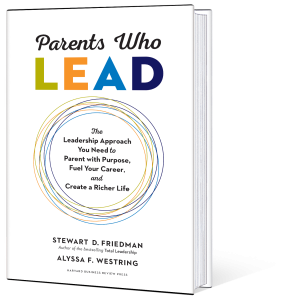 Raising the next generation has always been a group project that involves not just parents but also grandparents, aunts and uncles, siblings, and the larger community. But today’s working parents find themselves increasingly isolated from the support systems they need. And although working fathers and mothers too often feel overwhelmed, isolated, and somehow to blame for the difficulties they encounter in trying to manage it all, this is a large-scale problem for all of us, whether or not we have children of our own. Society depends, of course, on the next generation and it is incumbent on all of us to ensure that all American children have what they need so that they can grow up to be strong and healthy stewards of our planet and our institutions. Raising children is not merely a vanity project – it is our project.
Raising the next generation has always been a group project that involves not just parents but also grandparents, aunts and uncles, siblings, and the larger community. But today’s working parents find themselves increasingly isolated from the support systems they need. And although working fathers and mothers too often feel overwhelmed, isolated, and somehow to blame for the difficulties they encounter in trying to manage it all, this is a large-scale problem for all of us, whether or not we have children of our own. Society depends, of course, on the next generation and it is incumbent on all of us to ensure that all American children have what they need so that they can grow up to be strong and healthy stewards of our planet and our institutions. Raising children is not merely a vanity project – it is our project.



